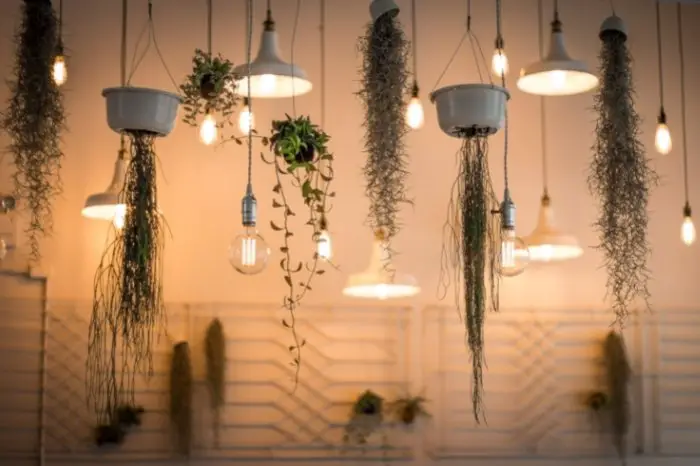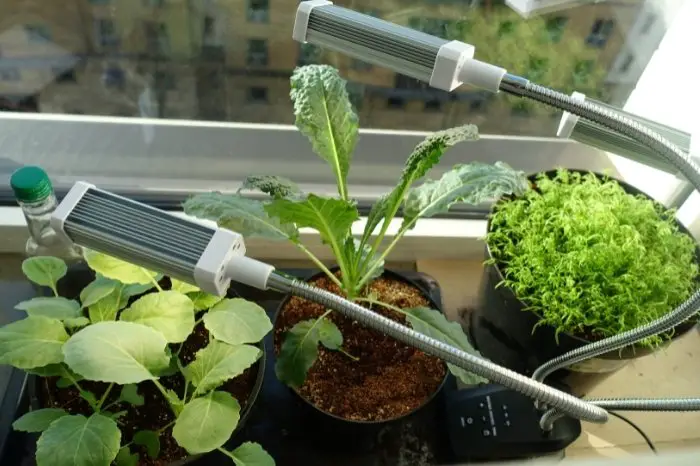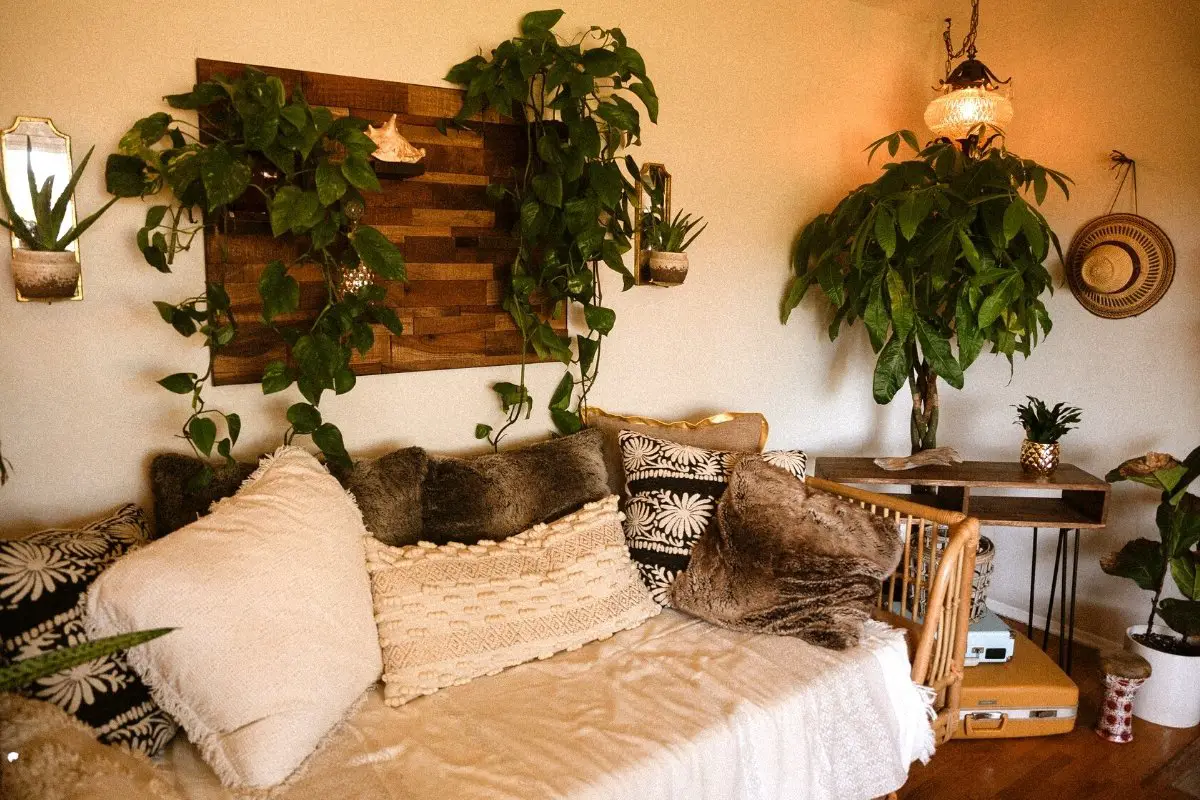Last Updated on January 17, 2022 by Cristina
Indoor plant lights decorative have been a subject of discussion recently, with many gardeners choosing to use them for indoor gardening.
Indoor plants are an excellent way to jazz up your surroundings as the greenery refreshes and adds color to your interior. However, it can be challenging to keep these plants alive, especially during the dark winters.
Excellent addition to indoor plants is the decorative grow light fixtures that keep your plants growing and a bright light even when darkness persists during the winter.
Types Of Indoor Plant Lights Decorative
Also known as artificial lights, they come in various types, and it could be tough to choose one or the other if you don’t understand the differences.
You can use any light or lamp fixture for regular house plants as long as you choose the correct bulb and place it where the plant can benefit the most.

Types of indoor plant lights decorative include:
Fluorescent Lights
These are by far the most economical and easy-to-use choices for houseplants. They come in compact bulbs (CFL), all tubes that fit into regular lamp sockets. These lights are cool enough to put close to plant foliage. The generic fluorescent bulbs and tubes are higher in blue wavelengths. When buying these bulbs, look for full-spectrum or a mix of cool and warm-colored bulbs. When in doubt, buy the cool white bulbs since white light contains the full spectrum of wavelengths. To provide maximum effect to your plants position your fluorescent lights about a foot away from the plant.
Read more about:
Incandescent Lights
These lights provide a lot of heat and should be placed further away from the plant. They produce more red wavelengths and can be used to supplement fluorescent lights or balance out the spectrum, especially if you’re trying to encourage your plants to bloom. You can mix the two lights by using a ratio of about 1/3 incandescent and 2/3 fluorescent lights by wattage.
LED Lights
This is a low heat energy-efficient artificial light. LED comes with customizable technology, so every bulb is different. Ensure that your bulb produces the reds and blues necessary for your plants. When buying LED bulbs, it’s best to source horticultural LED grow lights that produce wavelengths most utilized by plants rather than buying one for general use.
Halogen Lights
These lights provide a full spectrum light but emit a lot of heat. It is therefore vital to keep them away from the plant.
Horticultural Grow Light
These lights are packed in tubes for fluorescent fixtures. They have a full spectrum of wavelengths required for blooming plants such as African violets. Some gardeners use them when starting seeds or propagating hybrids.
What Kind Of Light Is Best For Indoor Plants?
The best light for indoor plants has the following features
The Right Color
Sunlight contains the complete spectrum of light that includes all the rainbow colors red, blue, yellow, violet, etc. Like plants growing outdoors under sunlight, indoor plants grow best under full-spectrum bulbs. These bulbs produce a balance of warm and cool light that replicates the natural solar spectrum. They are excellent for siblings and house plants, culinary herbs, and other plants. All the grow light fixtures and replacement bulbs are full spectrum.
Check Out A Deeper Study On When To Plant Crocus Bulbs
The Right Intensity
The light intensity is determined by the bulb’s brightness and how close it is placed to the plant. Plants require different light intensities. For example, plants that are native to tropical jungles or shady forests do not require as much light as plants that evolved in sunny, dry climates like the Mediterranean or southern Mexico. Some flowering plants like the begonias are happy to be at least 10 to 12 inches away from the light source. Foliage plants like philodendron can be placed as far as 6 inches away from the light source. However, many flowering plants like gardenias orchards require a much higher light intensity to flower and produce fruit.
LED Grow Lights for Indoor Plants, JUEYINGBAILI 80W Full Spectrum Plant Lights
The Right Duration
Whatever plants you’re growing, you must give them rest from light. When it’s dark, plants respirate, which is an integral part of their growth process. The amount of light a plant receives during its active growth time affects many biological processes, including the growth rate setting of buds and fruit. A built-in timer makes it easy to get the duration right. Botanists divide plants into three categories related to their preferred light duration.
Short Day plants include azaleas, begonias, etc.; thrive on less than 12 hours of light each day. These plants go through a series of shorter days before they set buds and bloom.
Long day plants include most vegetable seedlings, and garden flowers require 14 to 18 hours of light every day. If they don’t receive enough light, they get leggy and pale.
Neutral day plants include geraniums foliage plants, and African violets require at least 8 to 12 hours of light each day all year round.
Are LED Lights Good For Houseplants?
NASA pioneered LEDs to grow plants due to their research on the best lighting technology to produce edible crops in space. LEDs create light when an electrical current passes through a unique material known as a semiconductor. The semiconductor allows some light to pass through with crystals made of pure silicon conducting electricity.
So how do you illuminate indoor plants through led or fluorescent? Both of these lights produce full-spectrum light. However, early deserve better for your pocket and the environment. Horticultural LEDs have been manufactured as energy-efficient, economical and effective to meet plant needs. They deliver the bright full-spectrum lights, and plants require additional blue light to stimulate stronger root growth. LEDs are great for your plants because they are super-efficient, using lesser electricity than a fluorescent bulb. They are also environmental-friendly with Mercury-free LED tubes.

Final Thoughts On Indoor Plant Lights Decorative
Indoor plant lights decorative are your go-to solution for indoor plant light. When choosing your indoor plant light, remember to look at the types of indoor lights again before buying to make an informed decision. Happy indoor gardening using indoor grow lights.
Caroline is a gardener who loves to get down to the nitty–gritty of gardening. She proudly proclaims herself as a ‘dirt worshipper‘ and can often be found deep in the garden, covered in soil and singing to her plants. As a self–proclaimed ‘plant whisperer‘, Caroline believes that plants need love and attention just like any other living thing, and she loves to give them both. When she‘s not tending to her garden, you can often find her researching the latest gardening trends, or teaching others how to make their gardens thrive


